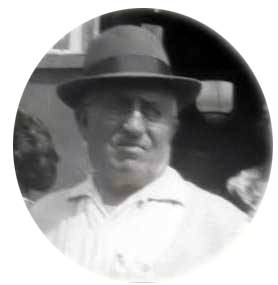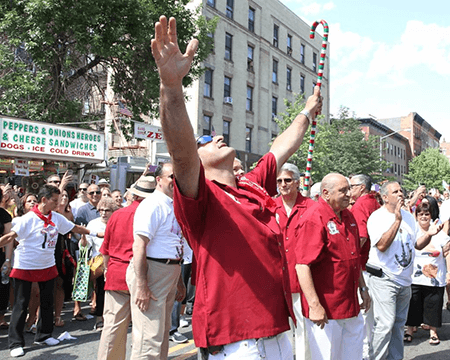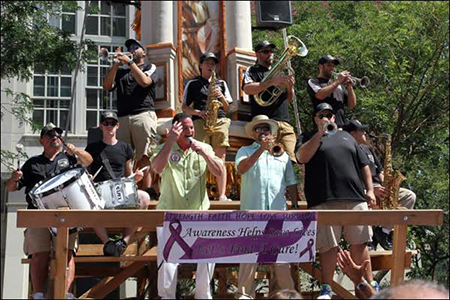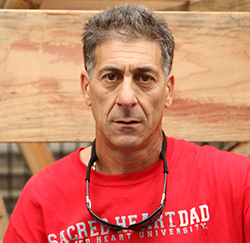Feast Rituals
Aliquet sagittis id consectetur purus ut faucibus pulvinar elementum integer. Egestas pretium aenean pharetra magna ac.
Updated: July 11, 2023

Erin is a lifelong Giglio Girl. The Zangaglia family have been members of the Giglio Feast since their arrival from Italy. Erin is currently the East Harlem Giglio President.
The East Harlem Giglio Feast Rituals
The East Harlem Giglio Feast was established on the streets of East Harlem, in 1908 by Italian immigrants from the town of Brusciano, Italy. These new Americans did not have much to carry with them on this long journey, but they did bring their beloved rituals and traditions from their homeland.
One of their most cherished customs was the annual Festa del Giglio or “Dancing of the Giglio” in honor of Saint Anthony of Padua.
The first Dancing of the Giglio in East Harlem was held on 106th street by Gioacchino Vivolo, and was attended by the many new immigrants from Brusciano or the “Bruscianese”. Gioacchino Vivolo, who was the grandfather of current East Harlem Giglio Capo Phil Bruno, is the first #1 Capo Paranza of the East Harlem Giglio Feast! Giaoacchino, along with his brother Rocco Vivolo, were original members of the Bruscianese Society and were very instrumental in bringing the tradition of the Giglio to East Harlem. This wonderful vision is still continued today by our Society and held up on the shoulders of the hundreds of lifters of the Giglio each year!
Many newcomers attend the feast and wonder: What does that mean? Why are they doing that? Who is that person? And it is understandable to wonder since there are many different rituals and customs which are performed during our annual feast! Many have very long history behind them, and have been passed down through the generations. So to help everyone understand the background and the “behind the scenes” of the East Harlem Giglio Feast, we have created this page:

The Rituals:
I noticed a person is listed as a #1 Capo. What does the #1 capo mean?
The #1 Capo is the key man on Giglio Sunday. He’s in charge of the whole day dishing out all the lifts to whomever he feels deserves one. In the Giglio world it is a prestigious position!
I notice after the first initial lift, the #1 Capo then hands the cane to different people. Who in turn each get a chance to command the Giglio? Who gets chosen to lead a lift? What does the cane mean?
The people who get a lift are usually people familiar with the Giglio and are known by everyone involved in the feast. Some of these people can be “Old Timers” who have been around for years and are known as feast dignitaries. The #1 Capo of the year gives the cane to the people he believes deserve the honor of having a lift.
The man in charge holds the cane and passes it on to all people getting a lift. The cane is a feast symbol handed down through the generations. It is used to direct the music and the dancing and walking of the Giglio.

I hear the person leading the lift refer to different kind of moves when he yells into the microphone giving his commands
They are referred to a # 1 lift and a #2 lift
What is a #1 lift?
A #1 lift is a “Regular” lift. When the known Giglio song starts and goes to a verse of the song the lifters then raise their legs and shoulders to essentially lift the Giglio off the ground and proceed to walk with it until the #1 Capo stops the walk or as it’s referred to “Dance of the Giglio”
I hear the commander of the Giglio say words into Italian when he stops the Dance each time. What is he saying?
Those words are commands which he yells into the microphone on the front pole. The words are in Neapolitan (an Italian dialect, though some call it a language in itself!) The famous words are:
Guagliu’! (Boys) Aizate ‘e Spalle! (Lift your shoulders!) Cuonci Cuonci! (Nice and Easy!) Aghiett! (Drop it!)
At this point the men of the paranza (Lifters) drop the Giglio back to the ground in one fluid motion.
What is a #2 lift?
A #2 lift is very similar to a #1 lift except when the #1 Capo stops the walk and announces on the microphone:
This is a #2, Uaglio! (Boys, Aizate i spalle! (Lift your shoulders¬), Cuonci Cuonc ! (Straighten your legs), Aggiet! (Throw it).
The men of the paranza (Lifters) drop the Giglio back to the ground and immediately pick it back up and dance it to another Giglio song. It is an amazing feat of strength. And amazing to see the Giglio go up and down in one motion. If you look up during a #2 lift, it seems as if St Anthony atop the Giglio is dancing himself.
I see guys with special button down shirts on during the Feast. Who are those guys?
There are a few different groups wearing special shirts. One group is the Board of Directors of the Feast. They consist of Capos (the group from which the #1 Capo is chosen) and Lieutenants. Also wearing special shirts are the Giglio Builders.
What does a Capo on the Board do?
Board member Capos run the basic inner workings of the Feast and the Society. From fundraising, entertainment, vendors, and all of the things you see going on were decided by the Board Capos.
What do Lieutenants do?
A lieutenant is assigned to a corner of the Giglio. They are in charge of a group of men that are on or around his corner of the Giglio. They are essential the lifters eyes and ears!
What are some of the duties of the Capos and Lieutenants on Giglio Sunday during the lift?
As you can imagine, to prevent injuries a lot of coordination is need when you have over 100 men lifting the Giglio and carrying it through the streets. The lieutenants keep an eye on the lifters they are responsible for, always keeping an eye on the #1 Capo to relay what’s going on with the lift to the lifters. Again, they are essential the lifters eyes and ears! Same holds true for all the other Capo’s.
Do the Giglio builders build the Giglio each year?
Yes they do! Each year you see a new Giglio freshly built! These men are specially trained in the old tradition to build the beautiful Giglios you see every year. They climb to the very top to make sure it is perfect and strong.
What does the Restoration Committee do?
The Restoration Committee works on the “face” of the Giglio, which periodically change depending on the Board’s decision. The current Giglio Face has been with us the past few years, it was handmade and given to us by our founding Giglio Society in Brusciano Italy and sent over by ship! Besides a few touch ups and painting, this face is an Original from Italy itself!
What is the proper way to lift the Giglio
Lifters that are on the right side of the Giglio should all lift with their left shoulder facing in towards the Giglio. Lifters on the left side of the Giglio should all lift with their right shoulder facing in towards the Giglio. It’s all about symmetry doing things equally towards the center of the Giglio for a nice even dance.
Do any songs mean certain things?
Sure do… Each neighborhood that had a Giglio feast has its own song. If you come from 106th street, The 106th street song means a lot to you. Same thing holds true for 108th street, The Bronx, Astoria, Brooklyn, etc.

Who decides what song for the band to play?
The choice of song is determined by the person who is doing the lift and what neighborhood he comes from. But it usually is his choice as to what gets played. The most popular songs played at the East Harlem feast are:
1) A Festa De Guagliune a 108th Street – Music & Verse by Salvatore “Tuddy” Ferrara
2) O’Giglio De 106th Street – Music by Felice Caccavale, Verse by Pasquale Ferrara
3) Valencia
4) Saint Anthony Hymn
5) Astoria Song from 1954
6) Brooklyn Song O’Giglio e Paradiso
How is the design of the Giglio face decided?
Our current Giglio was designed in Brusciano, Italy. This beautiful Giglio was given to us by our brothers in Brusciano. We are using this one for the past few years. Unlike Italy who designs and builds a new Giglio every year, we tend to use a Giglio for many years. The color may change from one year to another but the design stays basically the same. Alterations are made every year to the 5 pieces that make up the entire face. Weather is a huge factor and can affect the condition of the Giglio when the feast ends and the pieces are put back into storage. The design or alterations are usually decided by the person in charge of the restoration committee.
What is the height and weight of the Giglio?
In Italy the Giglio is 25 meters tall which converts to 82 feet. Here in NYC we tend to build smaller Giglio’s. The current Giglio is approximately 66 feet tall not counting the saint on top. So with the saint it’s about 72 feet. It can weigh anywhere between 3 and 4 tons depending on the height and wood used.
What is the weight of Giglio with band on top?
The band can add another 2000 to 2500 pounds to the weight of the Giglio. This depends on how many people are on the Giglio base, the size and weight of the musicians and singer and any guest that may be on the Giglio as its carried. The Giglio with band an instruments can at any given time weigh over 10,000 pounds!
How many people does it take to lift and dance the Giglio?
It usually takes about 80-100 people to dance it properly. But naturally the more lifters (paranza) under the “poles” the better!
Is there a different of Giglios between the East Harlem wood build structures as compared to Italy?
Italy’s Giglio’s are bigger in size but much lighter. One big difference between Italy and us is Italy uses a center board approximately 85 feet tall call “La Borda” in the middle of the Giglio that the frame of the Giglio is built around. This allows the Giglio to move more as the Giglio is carried (danced) through the streets.
What type of woods used?
Italy uses a much lighter wood call poplar, and chestnut for the poles. We use doug fir.

Who is in charge of the building of the Giglio?
The master builder is in total command of the builders. He decides how the wood is placed, and ensures the safety of the structure throughout the day.
Our Current Master Builder is Louie Z.

Who are some other master builders throughout the years?
Tony Cappola
Butchie Yanni
Vincent Yanni
Frankie Beard





